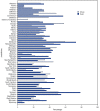Disparities in COVID-19 Vaccination Coverage Between Urban and Rural Counties - United States, December 14, 2020-April 10, 2021
- PMID: 34014911
- PMCID: PMC8136424
- DOI: 10.15585/mmwr.mm7020e3
Disparities in COVID-19 Vaccination Coverage Between Urban and Rural Counties - United States, December 14, 2020-April 10, 2021
Abstract
Approximately 60 million persons in the United States live in rural counties, representing almost one fifth (19.3%) of the population.* In September 2020, COVID-19 incidence (cases per 100,000 population) in rural counties surpassed that in urban counties (1). Rural communities often have a higher proportion of residents who lack health insurance, live with comorbidities or disabilities, are aged ≥65 years, and have limited access to health care facilities with intensive care capabilities, which places these residents at increased risk for COVID-19-associated morbidity and mortality (2,3). To better understand COVID-19 vaccination disparities across the urban-rural continuum, CDC analyzed county-level vaccine administration data among adults aged ≥18 years who received their first dose of either the Pfizer-BioNTech or Moderna COVID-19 vaccine, or a single dose of the Janssen COVID-19 vaccine (Johnson & Johnson) during December 14, 2020-April 10, 2021 in 50 U.S. jurisdictions (49 states and the District of Columbia [DC]). Adult COVID-19 vaccination coverage was lower in rural counties (38.9%) than in urban counties (45.7%) overall and among adults aged 18-64 years (29.1% rural, 37.7% urban), those aged ≥65 years (67.6% rural, 76.1% urban), women (41.7% rural, 48.4% urban), and men (35.3% rural, 41.9% urban). Vaccination coverage varied among jurisdictions: 36 jurisdictions had higher coverage in urban counties, five had higher coverage in rural counties, and five had similar coverage (i.e., within 1%) in urban and rural counties; in four jurisdictions with no rural counties, the urban-rural comparison could not be assessed. A larger proportion of persons in the most rural counties (14.6%) traveled for vaccination to nonadjacent counties (i.e., farther from their county of residence) compared with persons in the most urban counties (10.3%). As availability of COVID-19 vaccines expands, public health practitioners should continue collaborating with health care providers, pharmacies, employers, faith leaders, and other community partners to identify and address barriers to COVID-19 vaccination in rural areas (2).
Conflict of interest statement
All authors have completed and submitted the International Committee of Medical Journal Editors form for disclosure of potential conflicts of interest. No potential conflicts of interest were disclosed.
Figures


References
-
- CDC. COVID-19: rural communities. Atlanta, GA: US Department of Health and Human Services, CDC; 2021. Accessed March 31, 2021. https://www.cdc.gov/coronavirus/2019-ncov/need-extra-precautions/other-a...
-
- Dobis EA, McGranahan D. Amber waves: rural residents appear to be more vulnerable to serious infection or death from coronavirus COVID-19. Washington, DC: US Department of Agriculture, Economic Research Service; 2021. https://www.ers.usda.gov/amber-waves/2021/february/rural-residents-appea...
-
- CDC. Monitoring the nation’s health: 2013 NCHS urban–rural classification scheme for counties. Atlanta, GA: US Department of Health and Human Services, CDC; 2014. https://www.cdc.gov/nchs/data/series/sr_02/sr02_166.pdf
-
- US Census Bureau. Population and housing unit estimates. Washington, DC: US Department of Commerce, US Census Bureau; 2021. Accessed April 7, 2021. https://www.census.gov/programs-surveys/popest.html
MeSH terms
Substances
LinkOut - more resources
Full Text Sources
Other Literature Sources
Medical
Research Materials
Miscellaneous

